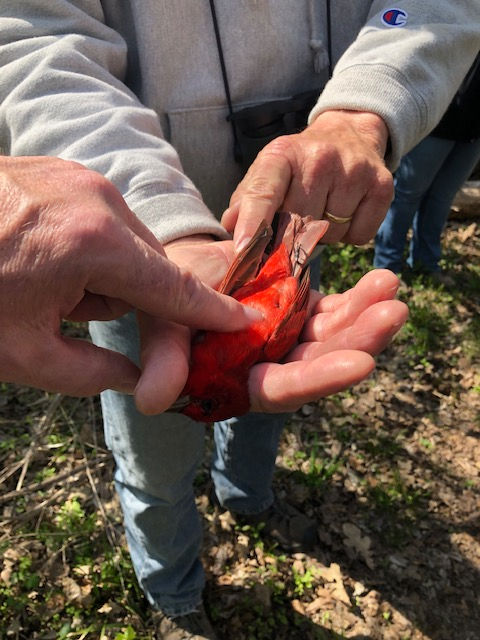On April 29, a band of nature lovers met with Dr. Russ Benedict to learn about the birds of Big Rock Park. The Central College naturalist began with a lesson on how to use binoculars and then led the group on a mile walk around the woodsy exterior of the park while he talked about avian migration patterns and all things bird. Some birds such as robins are generalists and will live anywhere. Others such as the tufted titmouse, are very picky about their habitats and will only nest in diverse oak forests as found at Big Rock Park. Spring migration is a race against time and weather, an orchestrated frenzy to establish territory.
Below: Binoculars Up! Focus binoculars, spot the bird, quickly raise the binoculars. Photos by -Kayla Lindquist www.kaylalindquistphotography.com


One prevalent bird was the Yellow-rumped warbler or butter butt—one of the few birds that can eat waxy fruit such as bayberries and will even eat candles! This helps them survive brutal winters.
It was a beautiful and sometimes noisy walk. Carolina wrens popped up and scolded while hairy woodpeckers pecked their holes in soft wood. A woodpecker will make a new hole every year!
In terms of migration, the over 400 species of Iowa birds fit into one of these categories:
Permanent residents such as cardinals, blue jays, owls, crows, and nuthatches. Chickadees not only are permanent residents, they rarely move more than three miles from their place of birth. Another fun fact about chickadees is their call. The more “dees” you hear, the more alarmed they are about their situation.
Nuthatches, as shown below, usually don’t migrate and prefer to live near mature trees as found at Big Rock Park. These photos were taken by Central College student Kayla Lindquist. Be sure to take a look at her other photos at www.kaylalindquistphotography.com


Barred owls are another permanent resident. They can be seen in Big Rock Park year around.

(photo by Sheril Graham)
`Regular Breeding residents who migrate here for the spring and summer as seen with many song birds including warblers and thrushes (such as robins), hummingbirds, bluebirds, and catbirds. These birds usually fly at night and stop to eat and rest in daylight. Turkey vultures migrate into Iowa in the spring since they can’t eat frozen roadkill. Turkey vulture watchers say the big birds are arriving earlier and earlier due to climate change.
Snow birds who winter here and fly north to breed such as eagles, juncos, gold finches, and tree sparrows.
Passage birds who fly through on their way to someplace else including many water birds and grackles.
When birds migrate, the males usually take flight first. They want to establish a territory. In the earliest wave of migrators, you’ll find the seed eaters, followed by insectivores, and lastly, caterpillar eaters. Usually, daylight patterns (photoperiods) prompt birds to migrate. In the spring, some might try their luck and migrate earlier or farther north than usual. This poor male
Summer tanager came here too early and starved.

Females pick males based on territory, but courtship plays a role, too. Birds have specific behaviors such as twittering their wings and singing to attract a mate. The most appreciated males croon for a long period of time. In birds such as blue jays, catbirds, and mocking birds, the most virile are those who sing up to five minutes without repeating a pattern.
Birds can see ultraviolet light and will display UV active patterns which help them distinguish between males and females. Bird feathers act as tiny diffraction gratings, displaying colors and iridescence.
Bird populations are declining in the US and across the globe. Grassland birds such as meadow larks are suffering the biggest loss while water birds are faring the best. Here in Iowa, loss of habitat and CRP fields due to ethanol are big contributors to the decline along with fewer insects.
Ways to save birds include putting up nest boxes which was highly successful with bluebirds. Turning off lights and using curtains to keep birds from hitting windows ,and buying shade grown coffee are a few more ways to help birds. Preserving wild places like Big Rock Park is one of the best ways to help keep bird populations alive. (Click the link for more ideas.)
Birdwatching is inexpensive and hip. A helpful resource for newbies and experienced birders is the All About Birds site. Big Rock Park offers an easy walk. Come fall, the migratory birds will leave the park at a much more leisurely pace than they arrived. If you want to hear the chorus and watch their spring frenzy, now’s the time.
Thank-you to the Marion County Community Foundation and Pella Community Foundation for sponsoring our nature event series.

Comments